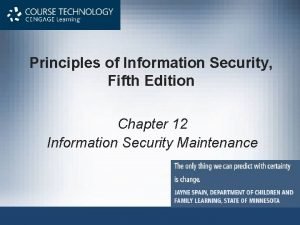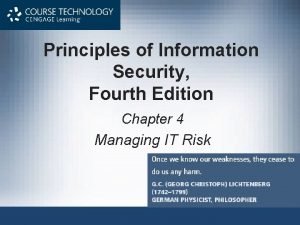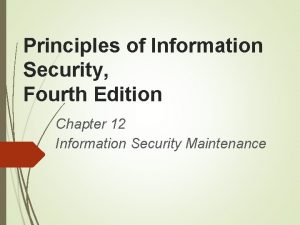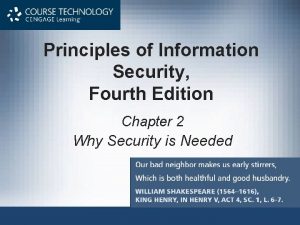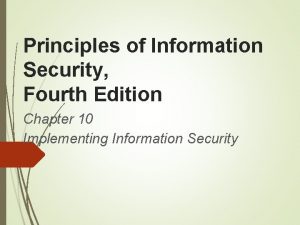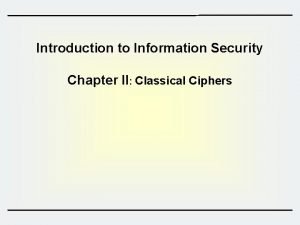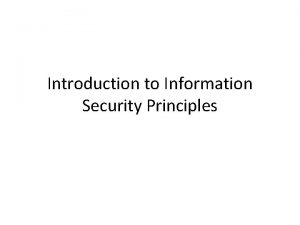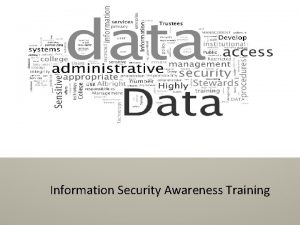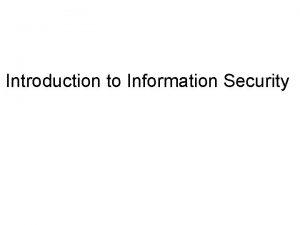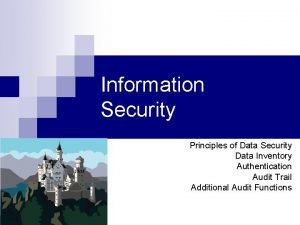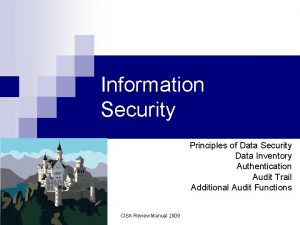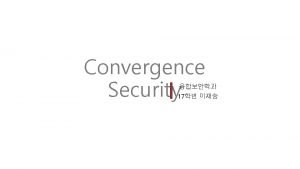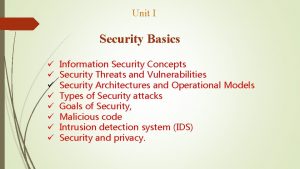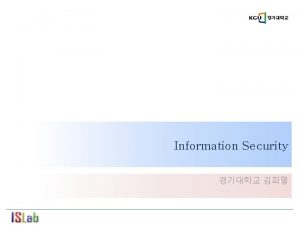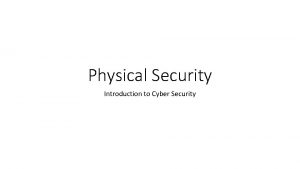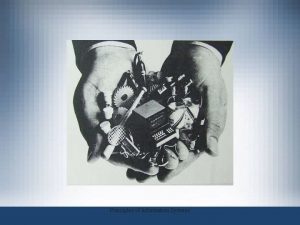Introduction to Information Security Principles What is Information

















- Slides: 17

Introduction to Information Security Principles

What is Information Security about? • Society is increasingly more reliant on computers • Placing trust on computer applications is a necessity • But are all computer systems trustworthy? – i. e. , Do all computer systems deserve our trust? • Trust is placing your confidence in something • Trustworthiness is placing confidence correctly – Trust is belief that a system will operate in an expected manner with attacks causing minimal damage to system and users – Trustworthy systems do operate in an expected manner and resist damage from attacks

What is Information Security about? (cont’d) • Information security studies ways to make systems trustworthy – By assuring a computer system will behave reasonably even in the face of malicious attacks • NIST Cybersecurity Framework – Describes five functions of information security 1. 2. 3. 4. 5. – Identify Protect Detect Respond Recover (system vulnerabilities, risks) (the system from attacks) (attacks on the system if they occur) (to attacks in a reasonable way) (from attacks to cause minimal damage) Each function contains outcomes and describes use of standards, guidelines and practices

NIST Function #1: Identify? • Vulnerabilities – Weaknesses in system that expose it to an attack • e. g. using non validated external data allows SQL injection attacks • Threats or attackers – Adversaries who may exploit vulnerabilities • Includes unintentional blunders, hackers, disgruntled employees, organized crime, market competitors, foreign nations • Potential threats vary based on given system – e. g. , student grades are unlikely to be targeted by a foreign nation or organized crime • Risk – The expected damage from a security violation. • Includes likelihood of a vulnerability being exploited and cost of damage – e. g. web service may have vulnerability, but if it’s not connected to network, risk is zero • Attack vectors – Describes how attacker could carry out an attack • e. g. , malicious email attachment, SQL code injection, tricking human operator

What is Information Security about? (cont’d) • Information security is a process – It is never done! Always trying to improve • How does this relate to the NIST Cybersecurity Framework? – Some examples … • Identify a vulnerability, adjust system to protect it • Detect an attack, respond and recover • Detect an attack, identify attack vector, adjust system to protect it

Cybersecurity is Inter-disciplinary • Information security requires more than just technical knowledge and solutions – E. g. , Can technology alone solve social engineering attacks? • Spoofing someone’s email address (phishing attacks) • spoofing a bank’s web-site • How does this relate to the NIST Cybersecurity Framework? – Some examples • Identify a risk, change a company policy (e. g. , long-term retention of data) • Detect an attack – What is company’s ethical responsibility for contacting affected individuals? – What is company’s legal responsibility for notifying the public? – What is the economic impact to the company’s suppliers/partners? • Detect an email phishing attack, modify education strategy of employees

Goals of Security • C. I. A = Confidentiality, Integrity, Availability Confidentiality protect data from unauthorized disclosure Integrity assurance that data has not been altered in an unauthorized way Availability assurance that the data/service is accessible to those with access to it

Breaches of C. I. A • Confidentiality Breach Sensitive information reaches unauthorized persons • Integrity Breach Data is fraudulent or altered without authority • Breaches of availability Losing access to services Which security goal is violated? 1. 2. 3. 4. 5. 6. C A student’s private discussions with counselor is revealed to a teacher. A malicious attacker changes the A passwords of valid users, preventing them from accessing the site. A request to transfer $100 from account I is changed by attacker to $10, 000. An email that looks like it is from your I bank but in fact is a phishing attack A student’s records are released C without obtaining student’s permission. Not being able to access a web site if it A is under a denial of service attack

Balancing C. I. A • C. I. A goals are at odds with one another and must be balanced – Increasing availability usually decreases confidentiality and integrity • Example 1: Lockout a user’s account after several failed password attempts. – Good for confidentiality and data integrity, bad for availability – Is this a good security policy? • Yes for some settings (e. g. , email) • No for others (e. g. , medical records systems)

Balancing C. I. A (cont’d) • C. I. A goals are at odds with one another and must be balanced – Increasing availability usually decreases confidentiality and integrity • Example 2: Allow users to do queries over a population (e. g. find the average salary of Le Moyne Employees) – Good for availability and integrity, bad for confidentiality – Queries over a small population can reveal good estimates of salary of one person

Group Discussion (Balancing CIA) • How are security goals C. I. A being traded off below? – Students are only informed of the average grade of a homework assignment only if more than 10 students submitted it.

Perfect Security? • Since C. I. A goals are often at odds it is impossible to design systems with perfect security • Our goal is to minimize risk and to be aware (as much as is possible) of the risks that remain

Security Concepts that Support Trust (A. A. A. Nr) • Assurance – How trust is managed • Policies (i. e. , behavioral expectations) • Permissions (i. e. , behaviors allowed by agents) • Protections (i. e. , mechanisms to enforce policies and permissions) • Authenticity – Ability to determine that statements, policies, and permissions are genuine • e. g. ATM card and pin authenticates that you have right to make a withdrawal from your account • Anonymity – Not possible to attribute certain records or transactions to any individual • Non-repudiation (++) – Someone cannot deny something • i. e. , a user should be responsible for their actions and should not be able to deny what they have done

How to Authenticate? • Authenticate – Determine if statements, policies, and permissions are genuine – Authentication can be done based on • Something you know – e. g. , PIN, password, mother's maiden name • Something you have – e. g. , a driver's license, magnetic swipe card, car keys • Something you are – e. g. , biometrics (fingerprints, retina scans, etc. )

Breaches in A. A. A. Nr • In each scenario describe which concept authentication, assurance and anonymity is breached. 1. 2. 3. An individual under 21 uses a fake ID to get into a bar and buy alcohol. A wait staff takes a customer’s order. When the order is ready, the customer’s name is called and they must walk over to the bar to pick up their order. An individual under 21 goes into a bar and is asked to wear a green band to indicate that they are not allowed to purchase alcohol. The bar is crowded and the bartender misses the green band allows the individual to purchase alcohol.

Class Discussions (Cybersecurity is inter-disciplinary) • You work at a software company and discover a new vulnerability in an application that is already deployed. Should this be disclosed? – What are some ethical reasons to disclose? – What are some ethical reasons not to disclose? • San Bernardino case: FBI had i. Phone of suspected shooter – FBI could not access data on device (it’s data was encrypted) – Apple did not want to help FBI (by disabling its password policy) • i. e. , after 10 unsuccessful password attempts the device is locked – What arguments are in favor of the FBI? – What arguments are in favor of Apple’s position?

Group Work • Conduct a security review of one of the following scenarios by identifying – one vulnerability – threats or attackers for that vulnerability – attack vectors (i. e. how an attack would be carried out by attacker) – how risky the vulnerability is – at least one entity we trust to not take advantage of the vulnerability – at least one possible way to mitigate the vulnerability even if entity is untrustworthy • Paying with Credit Card at Restaurant – At a sit down restaurant the waiter/waitress brings your bill, you hand over your credit card, the card is taken to the register to ring up your order and brought back to you in approximately 5 minutes. Turkey Trot – You and your cousin decide to run in this year’s turkey trot (good for you!). You can register online up to 3 months prior to the race. On the morning of the race, pre -registered individuals tell the race officer their name. The race officer checks the list of pre-registrants to make sure the name is on a list, and hands over the race bib. •
 Privat security
Privat security Visa international security model in information security
Visa international security model in information security Information security
Information security Principles of information security 5th edition pdf
Principles of information security 5th edition pdf 12 principles of information security
12 principles of information security Principles of information security, 7th edition
Principles of information security, 7th edition Information asset classification worksheet
Information asset classification worksheet 12 principles of information security
12 principles of information security Principles of information security 4th edition
Principles of information security 4th edition Bull's eye model in information security
Bull's eye model in information security Introduction to information security chapter 2
Introduction to information security chapter 2 Osi standard for security architecture is
Osi standard for security architecture is Guide to network security
Guide to network security Wireless security in cryptography and network security
Wireless security in cryptography and network security Electronic mail security in network security
Electronic mail security in network security E commerce security policy
E commerce security policy Software security building security in
Software security building security in Security guide to network security fundamentals
Security guide to network security fundamentals




